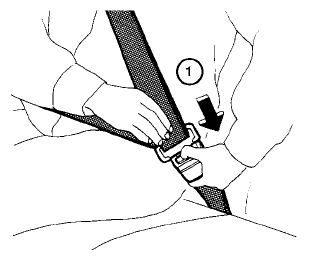Nissan Murano: In case of emergency / Towing your vehicle
When towing your vehicle, all jurisdictional and local regulations for towing must be followed. Incorrect towing equipment could damage your vehicle. Towing instructions are available from a NISSAN dealer. Local service operators are generally familiar with the applicable laws and procedures for towing. To assure proper towing and to prevent accidental damage to your vehicle, NISSAN recommends having a service operator tow your vehicle. It is advisable to have the service operator carefully read the following precautions:
WARNING
- Never ride in a vehicle that is being towed.
- Never get under your vehicle after it has been lifted by a tow truck.
CAUTION
- When towing, make sure that the transmission, axles, steering system and powertrain are in working condition. If any of these conditions apply, dollies or a flatbed tow truck must be used.
- Always attach safety chains before towing.
For additional information, refer to “Flat towing for all-wheel drive vehicle” in the “Technical and consumer information” section of this manual.
 If your vehicle overheats
If your vehicle overheats
WARNING
Donot continue to drive if your vehicle
overheats. Doing so could cause engine
damage or a vehicle fire.
To avoid the danger of being scalded,
never remove the radiator or coolant
reservoir cap while the engine is still
hot...
 Towing recommended by NISSAN
Towing recommended by NISSAN
NISSAN recommends towing your vehicle
based upon the type of drivetrain. For additional
information, refer to the diagrams in
this section to ensure that your vehicle is
properly towed...
Other information:
Nissan Murano (Z52) 2015-2024 Service Manual: L Terminal Circuit (short)
Diagnosis Procedure CHECK “L” TERMINAL CIRCUIT (SHORT) Ignition switch OFF. Disconnect generator connector. Ignition switch ON. Does charge warning lamp illuminate? YES>> GO TO 2. NO>> Refer to Work Flow (With 165-DSS-5000P), or (Without 165-DSS-5000P)...
Nissan Murano (Z52) 2015-2024 Service Manual: C1a04 Abs/tcs/vdc System
DTC Description DTC DETECTION LOGIC DTC No. CONSULT screen terms DTC detection condition C1A04–97 ABS/TCS/VDC CIRC (ABS/TCS/VDC circuit) Diagnosis condition When Ignition switch is ON. Signal (terminal) — Threshold If a malfunction occurs in the VDC/TCS/ABS system Diagnosis delay time — POSSIBLE CAUSE ABS actuator and electric unit (control unit) FAIL-SAFEThe following systems are canceled: Intelligent Cruise Control Automatic Emergency Braking (AEB) Intelligent Forward Collision Warning (I-FCW) DTC Confirmation Procedure CHECK DTC PRIORITY If DTC “C1A04–97” is displayed with DTC “U1000–01”, first diagnose the DTC “U1000–01”...
Categories
- Manuals Home
- Nissan Murano Owners Manual
- Nissan Murano Service Manual
- Tire rotation
- All-Wheel Drive (AWD) (if so equipped)
- Memory storage function (key-link)
- New on site
- Most important about car
Unfastening the seat belts. Checking seat belt operation
Unfastening the seat belts

To unfasten the seat belt, press the button
on the buckle  . The seat belt
automatically
retracts.
. The seat belt
automatically
retracts.
